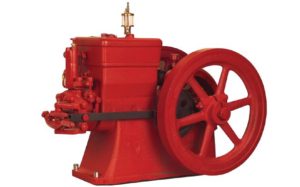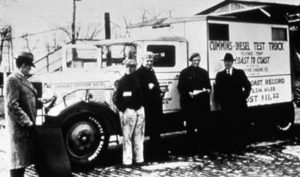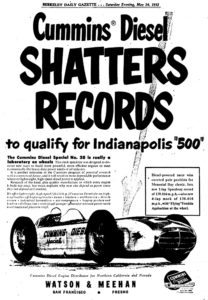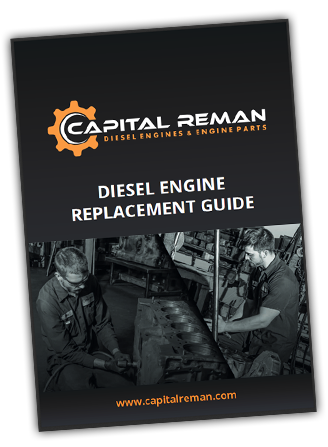Cummins Engine History: American Gumption
 Clessie Cummins and Race Crew - 1934 Cummins History Timeline
Clessie Cummins and Race Crew - 1934 Cummins History Timeline
Like most success stories, the history of Cummins Engine Company, started from humble beginnings and a perseverance to try something new. The early days of Cummins Engines were not like what we have all come to expect from the power generation giant of today. In fact the company almost folded a few years after its start.
Cummins Inc. was found in 1919 by Clessie Cummins in Columbus, Indiana. Clessie Cummins was no business genius; just a man with a vision and gumption to put in some hard work which would later be synonymous with his diesel engines. Clessie was born December 27, 1888 in rural Indiana, had no formal education beyond the eighth grade and had to leave to school to work on the family farm. Clessie was always very mechanical inclined and as legend has it, at 11 years old, he built his own steam engine from molten cast iron he poured into wooden molds. The steam engine worked and was used to pump water on the family farm.
Young Clessie knew that farming wasn’t something he wanted to do with his life and sought out on his own. All thing mechanical fascinated him. Not only did Clessie have a passion for all thing mechanical but also grasped the engineering and creative principals needed to become a master mechanic. Clessie took odd jobs around Indiana until landing a job as a mechanic with automotive maker Nordyke and Marmon(Marmon Motor Company) which made some of the first luxury cars in America before being bought out by Allis-Chalmers in 1926.
Humble Beginnings
Through a friend at Nordyke and Marmon, Clessie was hired by race car driver Ray Harroun who entered the now famous Marmon-Wasp in the first ever Indianapolis 500, also known as the brickyard. It was nicknamed “The Brickyard” because the 2.5 mile track was made entirely out of brick. Clessie was part of the pit-crew and made many suggestions to improve the speed and handling of the car. Clessie was part of history; the first ever Indianapolis 500, in 1911, was won by Ray Harroun and team running the 1911 Marmon Wasp. The car had the first ever rear-view mirror in history which helped win the race. Clessie would take this sense of accomplishment with him the rest of his life and spurred his love of racing. Cummins engine history is steeped in racing and would play a part in growing the company. First Cummins Hvid Engine - 1919 Cummins History Timeline
First Cummins Hvid Engine - 1919 Cummins History Timeline
It was during his time with Ray Harroun and The Marmon Motor Company that Clessie caught the eye of William Irwin. Irwin was the financial backer of Harroun’s Race Team and venture capitalist in the Columbus, Indiana area. Irwin noticed Clessie had a knack for everything mechanical and thought of ways to help empower the young Cummins. Clessie made money on the side by working as a chauffeur and mechanic for Irwin. Clessie impressed Irwin by building a gasoline engine prototype in Irwin’s garage from scratch in 1915. Irwin and Clessie worked on mechanical projects in the early 1900s eventually deciding to build engines themselves for local farmers. The friendship between Clessie and Irwin would go on to last a lifetime.
Irwin and Cummins were first introduced to diesel engines in 1918 when they witnessed an imported Dutch engine from manufacturer R.M. Hvid Company on tour in the United States. Cummins and Irwin were impressed with the new technology (only invented 19 years earlier by Rudolf Diesel) and sought a way to distribute Hvid engines to customers in America. After traveling to the Netherlands, Irwin and Cummins were awarded a license to sell Hvid engines in the United States. It also helped that Irwin was the National Director of the United States Department of Commerce and helped facilitate the deal. Winning Marmon-Wasp Race Car - 1911 Cummins Engine History Timeline
Winning Marmon-Wasp Race Car - 1911 Cummins Engine History Timeline
In 1919, with $10,000 from Irwin, Cummins Engine Company was formed in Columbus, Indiana. Cummins produced a re-designed 8 hp Hvid engine with his own improvements. The company made enough money to cover the costs of operations. By 1921 Cummins had successfully secured 2 out of 33 submitted patents for improved fuel efficiency and manifold technology for the licensed Hvid engines. Cummins Factory - Cummins Engine History Timeline
Cummins Factory - Cummins Engine History Timeline
By 1924 Cummins applied his new designs to his own Model F engine which was entirely designed on his own accord, thus ending the partnership with R.M. Hvid Company. Irwin backed the Model F production with $100,000.
Cummins then successfully negotiated with Sears Roebuck and Company to sell their engines in the famous Sears’ Catalog. Initially, business was booming for the new company. However, the Sears’ Catalog advertising venture became a disaster for Cummins. Many farmers took advantage of a loophole provided by Sears’ return policy. They purchased the engines, used them for a single season, and then returned them for a refund. Engines were run at full load without regard for safety or maintenance. Irwin, who as Cummins’ financial backer, was not happy with the durability of the diesel engines the company was putting out and encouraged Cummins to improve the design and reliability of the diesel engines. It is said that the first limited engine warranty was born from these early trials and tribulations to protect manufactures from reckless consumers.
Cross Country Promotional Trips
 Cummins Diesel Powered Packard - 1930 Cummins Engine History Timeline
Cummins Diesel Powered Packard - 1930 Cummins Engine History Timeline
Cummins realized that industrial application engines were not the best route for the growing business considering the wear farmers did to their engines. Dirt, mud and foliage particulate matter often clogged the engines, which were at the time often exposed to the elements on makeshift plows. Cummins was convinced the future of diesel engines was in over-the-road trucks and cars. To demonstrate the efficiency of diesel to the general public he installed one of his diesel engines in his 1926 Packard and drove from Indiana to New York. The event was not publicized but Cummins had in his mind to present the car at the 1930 New York Auto Show at the end of his journey. The car drove 800+ miles having only used a mere 30 gallons of fuel. The diesel engine averaged 26 miles per gallon which is an amazing feat which is still quite impressive today.
When Cummins got to New York he was turned away from the auto show as he was not a registered exhibitor. However, Cummins was determined to show the public his invention and he once again tried to display his car at the nearby Atlantic City Auto Show only to be turned away. Cummins had a brilliant idea to rent the empty space across the street from the convention center. His perseverance paid off and it turned out his exhibit ended up being more of a major attraction than most of the cars at the actual auto show. Early Cummins Model F Engine - 1930s Cummins Engine History Timeline
Early Cummins Model F Engine - 1930s Cummins Engine History Timeline
Cummins’ first taste as a “showman” turned out to be very successful. Even though the country was in the midst of a Great Depression, Cummins had already decided to go ahead and market a strictly over the road diesel engine for the consumer market prior to 1929. The orders from his Model U engines poured in after his first auto show appearance. However, Cummins had not anticipated the demand. The engine guzzled oil and he had made no provisions for an assembly line process in his factory back in Indiana. This first consumer diesel engine would be known as the Model U. Model U Cummins engine history is a bit blurry today but there are still a few left in the world which actually still work. It was Cummins’ goal to get his engine mass produced by one of the budding automakers in America. First he had to prove his diesel engine was every bit economical and could compete with gasoline engines which were in the majority of automobiles. Cummins sought to do this with a “PT Barnum” style of exhibitions throughout the country. A lot of interest in diesel dried up when the stock market crashed in 1929 but Irwin continue to support the company to stave off bankruptcy.
Tough Times: Great Depression Era
 Cummins and Team Truck Exhibition - 1931 Cummins History Timeline
Cummins and Team Truck Exhibition - 1931 Cummins History Timeline
Before the Stock Market Crash of 1929 Cummins had hoped that his engines would be a luxury items installed in prestigious cars. In fact, many of his engines were used in luxury yachts and marine applications. However, after the depression set in all of that luxury market disappeared. A new market though appeared to be the right fit for Cummins’ Engines: Over The Road Trucks. William Irwin just so happened to own a controlling interest in Purity Supreme Supermarkets in California. Cummins convinced Irwin to install his diesel engines in his fleet of trucks used to transport food goods from the warehouses to the stores. It was the perfect fit for the two companies. The diesel engines performed better on the steep mountain roads, were less prone to maintenance issues than gasoline engines are were more fuel efficient. The word spread about the benefits of using diesel engines in heavy duty trucks and the over-the-road truck industry was born. Cummins would become synonymous with truck engines from that point on. Truck engines would keep the company going but Cummins still had his sights for something bigger. He envisioned diesel engines in every car in America. That dream would never fully take off; it took a while but the majority of Cummins' customer base would be involved in the trucking industry vs. the direct to consumer automobile market. Cummins Test Bus - 1930s Cummins Engine History Timeline
Cummins Test Bus - 1930s Cummins Engine History Timeline
Cummins was determined to keep moving forward and in 1930 he staged a smaller road trip to Daytona Beach, Florida to meet up with famed British racer Kaye Don who was attempting to set a new land speed record. Cummins made the 1,275 mile trip only using about $2.30 in fuel. He got 40 miles per gallon with a top speed of 80.5 mph and had all of the eye witnesses and receipts to prove it too. The reporters were amazed with the efficiency of the engine and the wire reports went out all over the world. Cummins was gaining traction despite tough economic times.
The second great exhibition Cummins staged happened in 1931 where he drove from New York to Los Angeles. Unlike the first road trip Cummins embarked upon a year earlier, this one was high publicized. The journey was made in a Marion Truck outfitted with a Model U engine. The trip would cover over 3,000 miles over a network of dirt roads and poorly paved thoroughfares. Cummins managed to complete the journey in only 97 hours; more than 25 years before the construction of the national interstate highway system instituted by President Eisenhower.
The success of the second exhibition led to some notoriety nationally for Cummins. He followed his success with another cross country trip however this time with a bus. That journey from, New York to Los Angeles, took 91 hours and achieved top speeds of 60 to 65 mph. The speed of this cross country journey proved to be faster than many of the passenger train routes of the day. Cummins saw the future of the automobile in America and put all of his eggs into the over-the-road basket. He envisioned a day when all cars would be run with diesel engines.
First Racing Success at Indianapolis Motor Speedway
 Cummins Early Race Car Prototype - 1930s Cummins History Timeline
Cummins Early Race Car Prototype - 1930s Cummins History Timeline
Cummins realized that speed tests and more importantly the sport of racing was becoming big business. He wanted the inside track on gaining access to the racing demographic. In 1931 Cummins successfully logged 13,535 miles of track time at Indianapolis Motor Speedway in test runs of his Model U Marine Engine. These tests further cemented Cummins as a notable name in the automotive community, so much so that on the advice of fellow enthusiasts Cummins decided to race himself. Cummins entered a diesel-powered Model A Duesenberg in the 1931 Indianapolis 500 and finished 13th. The most remarkable feat is that car finished the entire race without a single pit stop and only used 1 tank of fuel and reached an outstanding 86 mph! Cummins Diesel Race Car - 1950 Cummins Engine History Timeline
Cummins Diesel Race Car - 1950 Cummins Engine History Timeline
Cummins hoped that his racing and trial runs would help him land a major automaker however he could never put a deal together with longtime muse, Packard Motor Company. In 1935, for his third cross country trip, Cummins decided to seek out other automotive partners. Cummins sought out to make diesel engines a luxury item despite market conditions. In turn he sought out partners that produced higher end luxury automobiles. Auburn Motor Company, like Packard Motor Company, produced higher end luxury touring cars. Cummins swapped in a new lighter weight six-cylinder diesel engine, dubbed the Model H, into an Auburn 851 Sedan. The 1935 trip proved to be the best one yet as the car reached top speeds of 90 mph and reached an impressive 40 mpg. Cummins thought he was on the right track with Auburn however the company went out of business the following year.
It is important to note that a this time in the company history that, Clessie Cummins, in some respects, had tunnel vision. He would not give up his dream of trying to promote his engine for the commercial automobile market. For 20+ years Cummins would pursue the direct to consumer market. If the company had one failure it would be not recognizing what they were good at (truck engines) and focus solely on that. market. Still Cummins would push on with more and more test runs and races at Indianapolis Motor Speedway. Indianapolis 500 Poster - 1952 Cummins Engine History Timeline
Indianapolis 500 Poster - 1952 Cummins Engine History Timeline
In 1934 Cummins would return to the Indianapolis 500 with two new diesel cars. The first car was a two-stroke engine and the other a revolutionary new four-stroke engine. Both engines were turbocharged with Roots-Type superchargers that were blazing fast. Although the two-stroke engine finished ahead of the four-stroke engine it was smoking horribly from overheating. In fact the engine got so hot that the pistons melted into the block. It was this event that spurred Cummins to abandon two-stroke engines and solely make four-stroke engines. With greater speed came greater pressure on the pistons which facilitated the need to have four cycles. Four cycle engines consist of four separate parts to generate power: intake, compression, power creation and exhaust. World War I flying Ace Eddie Rickenbacker owned the Indianapolis Motor Speedway at the time, and was eager to hold exhibitions and speed tests with Cummins to keep his track afloat during the Great Depression. Cummins' tests grew great crowds!
The Cummins Corporation would go on to be a staple in the Indianapolis 500 for decades to come however a first place finish would never be in the cards for the company. The company pulled out all of the stops in the early 1950s hoping to produce a winning car. In the 1950 Indianapolis 500 Cummins entered the race with its “Green Hornet” car powered by a Model JS engine producing 340 hp however the car finished 29th. The closest Cummins got to the elusive first place finish was in 1952 Indianapolis 500 when the car took a first place qualifying position. However, during the race the car fell back and finished 27th. A post race inspection of the car revealed the turbocharger air inlet was clogged with rubber tire particles from the track. It was found that albeit diesel engines could obtain great speeds (over 100 mph) they were slow to ramp up and could not compete with gasoline engines out of the starting gate. Competing in racing would always mean the team would have to win from a come from behind position. Cummins experimented with superchargers and later turbochargers for that initial boost of speed, later acquiring Holset Turbochargers in 1973 but could never figure out how to have a 1st place car at Indy. Discouraged, Cummins never entered another car at the Indianapolis 500 and in-fact 1952 was the last year a diesel-powered race car ever competed at the event.
A New Dawn: Road to Economic Recovery
 The company continued to grow as the country recovered from the effects of the Great Depression. William Irwin was convinced that Europe was an untapped market and was in better shape than the US during the depression era. Cummins and Irwin toured all around Italy, France and Switzerland first starting in 1932 but making trips well into the late 1930s. The word spread and orders were placed back in Indiana for the European market. Like the US, Europe mainly was interested in diesel engines for semi-trucks. 1932 was really the tipping point for Cummins truck engines. That same year they landed a contract with large-truck maker Kenworth for the option of having a diesel engine built into the truck. The truck engine was a 4 cylinder, 100 hp, HA4 model. Subsequent events would also showcase the long distance capabilities of semi-truck engines.
The company continued to grow as the country recovered from the effects of the Great Depression. William Irwin was convinced that Europe was an untapped market and was in better shape than the US during the depression era. Cummins and Irwin toured all around Italy, France and Switzerland first starting in 1932 but making trips well into the late 1930s. The word spread and orders were placed back in Indiana for the European market. Like the US, Europe mainly was interested in diesel engines for semi-trucks. 1932 was really the tipping point for Cummins truck engines. That same year they landed a contract with large-truck maker Kenworth for the option of having a diesel engine built into the truck. The truck engine was a 4 cylinder, 100 hp, HA4 model. Subsequent events would also showcase the long distance capabilities of semi-truck engines.
All of this publicity was helping to push the company into the public conscience. The financial backers were equally impressed with the company’s growth. In 1934, William Irwin’s great nephew, J. Irwin Miller would become the general manager of the company and continue to run it for over 40 years. Under J. Irwin Miller’s leadership the company would turn its first profit in 1937 and in 1940 was the first engine manufacturer to offer a 100,000 mile warranty. The hardship of the earlier years would finally be erased as the United States entered World War II. Cummins produced mass quantities of engines for the US Government for every year of the war. Every engine produced was installed in trucks and sent to both the European and Pacific Theaters. The company obtained many military and civil contracts, expanded its facilities, increased it labor force tremendously and offered a full range of new engines. All major trucking companies used Cummins engines because of their reliability, torque ratio, horsepower and the excellent fuel mileage. Cummins Military Trucks in WWII - Cummins Engine History Timeline
Cummins Military Trucks in WWII - Cummins Engine History Timeline
After World War II Clessie Cummins decided not to go back to racing or promoting his engines in automobiles. Clessie had gone into semi-retirment leaving his brother, Donald Cummins, in a position to operate the company with General Manager J. Irwin Miller. The last big project Clessie worked on with Cummins was the ramp up of contracts required for the Korean War from 1950-1953. The 1950s and beyond would become a boom time for Cummins as the National Interstate Highway System was built all across the country. Newly paved roads opened up all kinds of new opportunities for over-the-road shipping. All of that transport meant more trucks equipped with Cummins Diesel engines.
The Golden Era of Clessie Cummins
 Clessie Cummins in Workshop Shortly Before Death - 1960s
Clessie Cummins in Workshop Shortly Before Death - 1960s
In 1955, at age 67, Clessie Cummins officially retired from the company that bears his name. He stepped down as Chairman of the Board and later formed Cummins Enterprises Inc. to tinker with designs of his own and modify patents he held. It is speculated that Clessie was forced to step down and that he never interfered with his “old” company ever again. Later he moved to California where he founded Allison Aircraft Engine Company.
The last great invention of Clessie Cummins would come towards the end of his life. On one of Clessie’s trips across the country he came across a steep grade near Cajon Pass in Barstow, California. Clessie was behind the wheel when the brakes failed on the truck. Clessie downshifted to slow down the vehicle only to his surprise to see a train speeding by at the bottom of the hill. Luckily for Clessie the train cleared the crossing only seconds before the truck ran over the tracks at 35 mph. It was this life changing experience that spurred an idea in Clessie.
Clessie began experimenting in the mid 1950s with way to slow down a truck in motion. Clessie Cummins Sr. and Clessie Lyle Cummins (Junior) found the answer in 1954. They developed an engine brake which consisted of a valve lifter that slightly opened the exhaust valves to release compression and prevent the fuel from igniting. The system was designed so that the driver could use a switch mounted in the cab to select the number of cylinder they wanted to release compression from. Cummins Executives with Clessie Cummins - 1950s Cummins History Timeline
Cummins Executives with Clessie Cummins - 1950s Cummins History Timeline
Clessie shopped the idea around to all of the major truck manufacturers but found no takers for his new technology. That was until Clessie’s nephew introduced him to the Jacobs Chuck Company who was famous for creating a three-bit rotating drill chuck. They backed the new invention and helped to sell the idea. By the late 1950s many big rigs were equipped with “Jake Brakes”. This was an emergency life saving device that is still in use today in big rigs and diesel pickups.
Clessie passed away at on August 17, 1968 at his home in California at the age of 80. It was said that he was even working on a concept engine in his basement days before his death. Clessie’s legacy is steep in history and lure. He wrote a short autobiography before his death but it is hard to find these days. His son Clessie Lyle Cummins’ biography of his dad is more well known and complete. Cummins Engine Company continued to grow long after Clessie’s death.
Cummins Engine Company Today and Beyond
 Dodge Rams with Cummins Engines
Dodge Rams with Cummins Engines
In 1989 Cummins Engines signed a contract with Dodge Truck Division to supply diesel engines for its Ram line of light duty pickups. General Motors had diesel engines in pickups since 1978 and Ford since 1983. Dodge had already tried Perkins and Mitsubishi engines in its pickups but were never massed produced. This contract with Dodge proved to be one of the most lucrative contracts for Cummins. The deal with Dodge was, in many ways, fulfilling Clessie’s dream of supplying his engines to a major automotive manufacture; something he was never able to do in life. In 2006 the 1.5 millionth diesel engine for the Dodge Ram came off the line in Columbus, Indiana. Modern Day Cummins Plant - 2015 Cummins Engine History
Modern Day Cummins Plant - 2015 Cummins Engine History
Cummins is now the largest over-the-road truck engine manufacturer in the world with 37.5% market share of the heavy duty diesel industry. Cummins is truly a global company. The first foreign manufacturing plant opened in Shotts, Scotland in 1956. Today Cummins has over 5,000 facilities in 197 countries. In fact, in 2015 more than half of the 19 billion in sales accounted for have come from outside of the United States.
Today Cummins is more than just an engine manufacturer but a multifaceted corporation concerned with engines, power generation, parts and components, used and remanufactured diesel engines and distribution. The company continues to innovate with newer more clean technologies to meet consumer demand as well as EPA regulations. In fact Cummins has come out with the first 90% NOx reduction engine ahead of the 2023 – 2031 upcoming EPA Tier regulations. Cummins Market Share Graph - 2015 Cummins History Timeline
Cummins Market Share Graph - 2015 Cummins History Timeline
Cummins Engines Company is truly a story of innovation and a never get up spirit. Through trials and tribulations along the way the company has survived on the same principals as Clessie installed in the company so many years ago: honesty, integrity and a relentless passion to keep innovating. It will be interesting to see how Cummins continues to dominate in the years to come.




